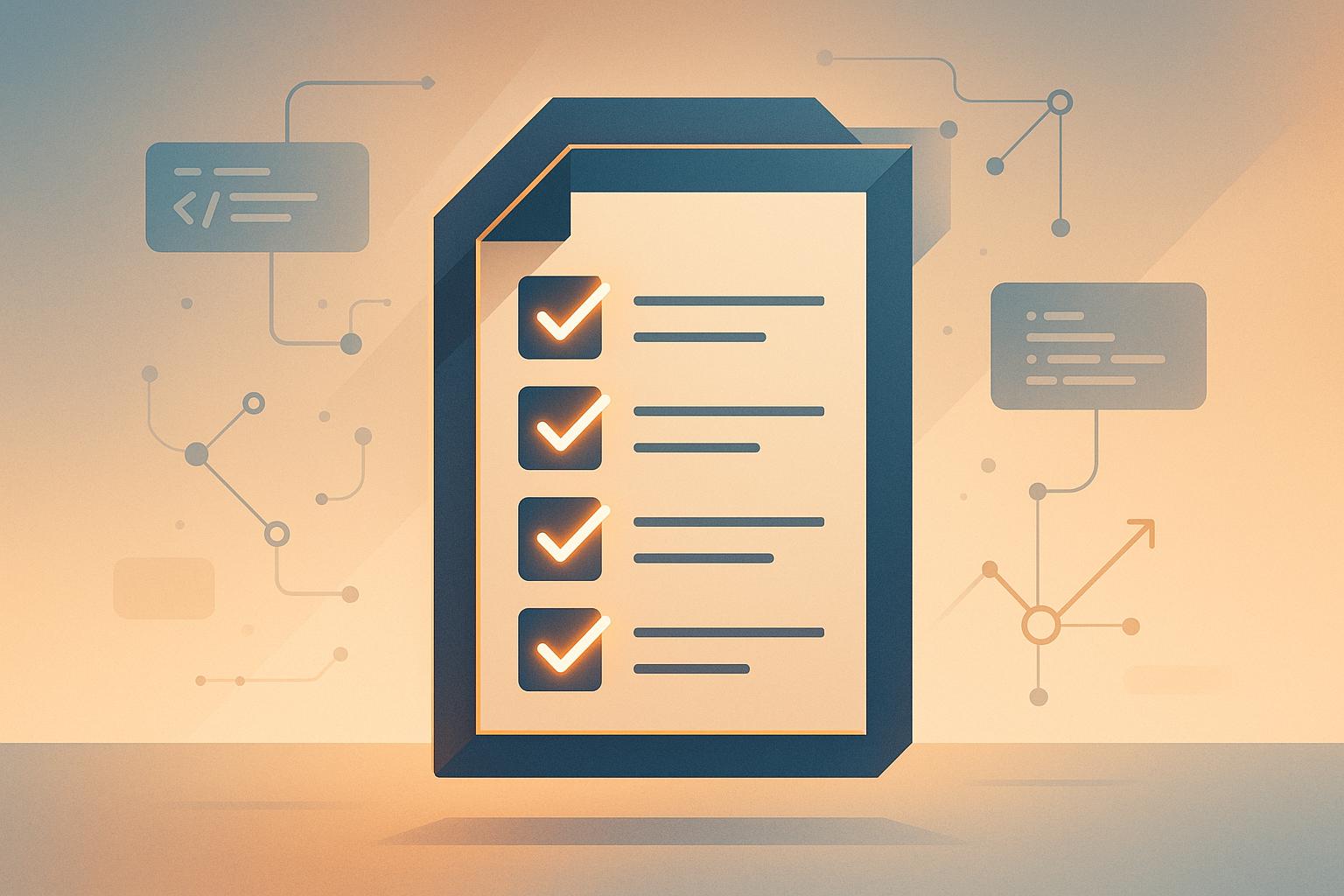


Learn why developer funnels fail after the first click and discover strategies to enhance engagement and conversion through effective targeting and messaging.
Developers are not like typical consumers. They need clear, technical details - not flashy ads or emotional appeals. Most funnels fail because they don’t align with how developers evaluate tools: Exploration → Demo → Internal Sale. Here’s why funnels break and how to fix them:
- Wrong Messaging: Vague claims and buzzwords don’t work. Developers want specifics like API docs, performance metrics, and compatibility info.
- Bad Targeting: Treating all developers the same leads to irrelevance. For example, backend engineers don’t care about frontend tools.
- Poor UX: Slow-loading pages or confusing navigation drive developers away. Mobile optimization is also a must.
- Complex Onboarding: Long forms or approval delays frustrate developers. They prefer instant access to test your product.
Fixes:
- Match Ads to Landing Pages: Deliver on promises with code examples, documentation links, and system requirements upfront.
- Simplify Sign-Up: Minimize steps, offer GitHub/Google SSO, and provide instant demos or sandboxes.
- Targeted Follow-Ups: Use behavioral data to personalize messages and re-engage users where they drop off.
Key stat: Companies with optimized funnels grow revenue 18x faster, yet only 17% of marketers have fully functioning funnels. Developers demand trust, relevance, and a frictionless experience - get these right to keep them engaged.
Sales Funnel Optimization - 5 Conversion Strategies
Why Developer Funnels Fail After the First Click
To convert developers effectively, you need to understand why funnels often break after that crucial first click. The root issues usually stem from not fully grasping how developers think and behave online. Each misstep erodes their trust and engagement.
Wrong Messaging
Buzzwords like "revolutionary" or "game-changing" don’t resonate with developers unless they’re backed by solid technical details. Developers are quick to dismiss vague claims, especially when messaging lacks specifics like performance metrics, integration capabilities, or links to documentation.
The problem worsens when companies rely on generic, one-size-fits-all messaging. For example, language aimed at executives often fails to connect with developers who care more about APIs, database performance, or compatibility with their existing tools. Developers need to see how a product works and fits into their workflow before they’ll consider broader business benefits.
Bad Targeting
Misaligned targeting is another common pitfall. Casting too wide a net often means showing irrelevant features - like promoting frontend solutions to backend developers - which leads to immediate disengagement.
This issue often stems from shallow audience research. Companies sometimes assume all developers have the same needs, but a DevOps engineer's priorities are vastly different from those of a mobile app developer. As The Fullstory Team puts it:
Understanding your audience and tailoring experiences to different segments is the most effective way to optimize your funnel.
Effective targeting starts broad but must quickly refine based on engagement. Without proper segmentation, campaigns fail to resonate and lose momentum.
Poor User Experience
Developers have little tolerance for clunky online experiences. Slow-loading pages or confusing navigation are instant deal-breakers. They expect websites that are fast, intuitive, and make it easy to find technical details like documentation.
Mobile optimization is another critical factor. Developers often look up resources on the go, and if your site isn’t optimized for mobile, you risk losing their attention altogether.
Complex Onboarding
An overly complicated onboarding process can derail even the most promising funnel. First impressions matter, and developers want to dive in and start testing right away - without jumping through hoops like long forms or waiting on approval emails.
Self-serve onboarding is key. Developers value the ability to experiment immediately, and the faster they can make their first commit, the better. A lengthy or confusing onboarding process not only frustrates them but also gives competitors with smoother experiences an edge. Every extra step is an opportunity for developers to abandon your product in favor of a more streamlined alternative.
How to Fix Developer Funnels
Fixing a broken developer funnel means addressing the points where developers lose interest or drop off, without sacrificing the technical depth they value. The goal is to reduce friction at every stage while keeping engagement high. Here are three focused strategies to improve developer retention and streamline their journey.
Match Landing Pages to Ads
Your landing page should deliver exactly what your ad promises. If your ad highlights quick API integration, for example, your landing page should immediately provide technical details, such as integration steps, supported programming languages, and performance metrics.
Developers value clarity and relevance, so include elements like:
- Code examples: Simple, actionable snippets to demonstrate functionality.
- Documentation links: Prominent access to API docs, SDK downloads, or technical guides.
- System requirements: Clear details on compatibility and setup.
Eliminate distractions like pop-ups, lengthy company history sections, or unrelated testimonials - these don’t serve a developer's immediate needs. The focus should remain on technical content that builds trust and showcases the product’s capabilities.
Simplify the Sign-Up Process
Keep the sign-up process as minimal as possible. Typically, only an email and password are necessary to get started. This reduces barriers and encourages more developers to engage.
To further enhance the experience:
- Offer instant demos or sandbox environments so developers can test your product right away.
- Integrate single sign-on (SSO) with platforms like GitHub or Google for a seamless process.
- Enable self-service onboarding to give developers immediate access to your tools without waiting for manual approvals.
Once developers are signed up, follow through with personalized engagement to keep them interested and active.
Use Targeted Follow-Up Messages
Understanding where developers drop off is key to crafting effective follow-ups. Use behavioral data to create tailored messaging for different stages of the funnel. For instance:
- Developers who visit your pricing page might appreciate detailed technical comparisons.
- Those who start the sign-up process but don’t complete it could benefit from a simplified reminder.
Personalize these messages based on observed interests. For example, if a developer views your Python SDK documentation, send follow-ups with Python-specific use cases and examples. Timing is also critical - send the first message within 24 hours of engagement, then space out additional communications based on activity.
Leverage multiple channels for re-engagement. While email is a primary method, consider using in-app notifications or retargeting ads on platforms that developers frequent. This ensures visibility without overwhelming them.
Finally, track metrics like open rates, click-through rates, and conversion rates to measure the success of your follow-ups. Use this data to refine your approach and focus on what works best for your audience.
sbb-itb-e54ba74
How daily.dev Ads Solves Developer Funnel Problems

To tackle the unique challenges of reaching developers effectively, daily.dev Ads offers a specialized platform designed specifically for this audience. Unlike generic advertising solutions, it understands the distinct behaviors and preferences of developers. Here’s how daily.dev Ads addresses common developer funnel issues:
Target Developers by Skills and Tools
One of the biggest hurdles in developer-focused campaigns is imprecise targeting. daily.dev Ads solves this by enabling segmentation based on specific programming languages, frameworks, and experience levels. Instead of broad demographic filters, you can narrow your audience to match your exact campaign goals. For instance, you could target senior Python developers or junior JavaScript developers based on their expertise.
This precision helps overcome the relevance gap that often plagues developer funnels. Take this example: a SaaS company promoting a new API tool used daily.dev Ads to target users who had interacted with Python-related content. The result? A 7% click-through rate - far surpassing the industry average of 2.35% - and a 4% conversion rate from sign-up to active trial.
Additionally, daily.dev Ads enhances targeting by analyzing developer interests through their reading habits and engagement patterns. This goes beyond basic demographics, offering a deeper understanding of your audience to fine-tune campaigns.
Native Ads That Don't Interrupt
Developers are especially sensitive to intrusive ads, like pop-ups or flashy banners, which can disrupt their workflow. daily.dev Ads takes a different approach by using native ad formats that fit seamlessly into the platform's content feed. In-feed ads appear alongside developer news, while post-page ads show up after users finish reading, maintaining a smooth browsing experience.
This non-intrusive strategy minimizes banner blindness and ad fatigue, encouraging developers to engage with ads that feel relevant and naturally integrated rather than disruptive.
Track Performance in Real-Time
daily.dev Ads provides real-time analytics to monitor every stage of your funnel. Metrics like impressions, clicks, click-through rates, conversions, and drop-off points are tracked as they happen, giving you immediate insights to make data-driven adjustments.
For example, if you notice a high click-through rate but a low sign-up rate, you can quickly experiment with a more streamlined registration form. Real-time data helps pinpoint whether the issue lies in your messaging, targeting, or user experience, allowing for rapid course correction.
The platform also supports retargeting, enabling you to re-engage developers who drop off at critical stages. For instance, you can serve personalized follow-up ads to users who visited your pricing page or started onboarding but didn’t complete it. Retargeting campaigns like these can increase conversion rates by up to 147%, significantly improving your funnel’s overall performance.
Building Better Developer Funnels
After analyzing common funnel failures and their solutions, it's time to focus on actionable steps to improve your funnel. The key to success lies in consistency and flawless execution. A well-designed funnel ensures developers get exactly what they need at every stage of their journey.
Main Takeaways
Messaging alignment is critical. If your landing page doesn't deliver on the promises made in your ad, developers will notice - and they'll bounce. Developers expect clear, technical details that directly address their challenges.
Precise targeting is non-negotiable. Broad demographic filters won’t work here. Developers respond better when you segment by specifics like programming languages, frameworks, or experience levels.
User experience matters more than you think. Developers are especially sensitive to slow or clunky interfaces. Landing pages that load in 1–3 seconds can boost conversions by up to 2.5 times compared to slower pages. Every second of delay lowers your chances of capturing leads.
Here’s a striking stat: organizations with well-structured sales funnels grow revenue 18 times faster than those without. Yet, only 17% of marketers have fully functioning funnels, and just 34% actively optimize them.
Personalization delivers results. Customized calls-to-action perform 202% better than generic ones. Similarly, tailored follow-up messages can triple lead-to-meeting conversion rates, increasing them from 10% to 30%. Developers expect timely, relevant communication - anything less feels like noise.
What to Do Next
Start by auditing your funnel to uncover messaging inconsistencies. Ensure your landing pages align with your ad promises and pinpoint where developers might drop off.
Streamline your onboarding process by reducing unnecessary steps. Minimize required fields and enable single sign-on to make sign-ups seamless. Experiment with different landing page designs to find what resonates most, and prioritize fast load times and mobile-friendly layouts.
Set up personalized follow-up sequences based on user behavior. For example, if a developer visits your pricing page but doesn’t sign up, send tailored content addressing common pricing concerns. If someone starts onboarding but doesn’t finish, offer additional resources to guide them through.
Consider using developer-focused marketing platforms to enhance targeting, ad placements, and analytics.
Finally, let data guide your decisions. Track metrics like landing page conversion rates, lead-to-customer ratios, and drop-off points at each stage. Use these insights to make informed adjustments, ensuring your funnel becomes a well-oiled machine that engages developers effectively.
FAQs
How can companies share technical details in their developer funnels without overwhelming their audience?
To communicate technical details effectively without overwhelming developers, it's essential to focus on clarity, brevity, and relevance. Tailor your content to address developers' specific needs and challenges. Instead of leaning on promotional material, offer resources like in-depth documentation, step-by-step guides, and case studies that showcase practical solutions.
Developers appreciate honest and transparent communication, so make sure your content is thoroughly researched and applicable to their work. Highlight technical benefits in a straightforward manner, steering clear of unnecessary jargon. To keep engagement high and build trust, consider personalized follow-ups that guide them through their journey.
How can I better segment developer audiences to improve my marketing funnel performance?
To better connect with developer audiences and refine your marketing funnel, start by analyzing behavioral data - things like their coding routines, the types of projects they work on, and the tools they rely on. This approach helps you craft messages that resonate with their specific interests and challenges.
You can also segment your audience based on professional roles (like frontend versus backend developers) and experience levels. By catering to these distinct preferences, your content and offers will feel more relevant, which can lead to stronger engagement, better retention, and improved conversion rates.
Why is mobile optimization important for developer-focused websites, and how does it influence funnel performance?
Why Mobile Optimization Matters
Mobile optimization is all about making sure your website works effortlessly on smartphones and tablets. With more people relying on these devices to browse, shop, and interact online, having a mobile-friendly site is no longer optional - it's a must. A well-optimized mobile site loads quickly, is easy to navigate, and keeps visitors engaged, which means fewer people leaving your site right away.
But it’s not just about user experience. Mobile optimization plays a big role in your website’s performance. It helps keep users on your site longer, encourages actions like sign-ups or purchases, and even improves your search engine rankings. Search engines favor mobile-friendly websites, so optimizing for mobile can bring in more organic traffic and improve your funnel’s overall effectiveness. In short, focusing on mobile optimization ensures a smoother experience for users and better results for your business.






